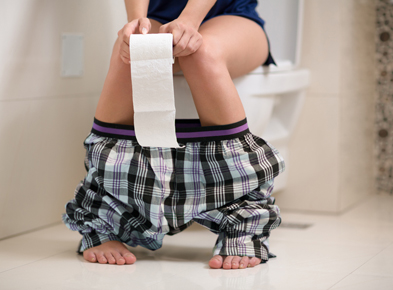

When you gotta go, you gotta go. But what happens after you’ve gone? How do you make sure you always leave feeling clean and refreshed? From wiping techniques to handwashing habits, we’ve got you covered for your toileting routine.
Yes. A thousand times, yes! Wiping is about more than just helping you clean up after you use the toilet – it’s also to protect your health. Wiping improperly can increase the risk of a urinary tract infection (UTI) and vaginitis in women, and UTIs, itching and general discomfort in men. So, you’ve got to make sure you’re using proper wiping technique to avoid infection.
Let’s dive a little deeper.
How do you hold your toilet paper? Interestingly enough, there are a variety of different ways people hold their toilet paper. The good news is there isn’t a right or wrong way to do it. You get to choose whatever way you like best:
Generally preferred by men, folders will fold the toilet paper into neat squares before they wipe. 54%1 of people claim to be a folder, although the majority is heavily skewed toward the male demographic.
Crumplers will press the toilet paper into a loosely shaped ball before they wipe. 26%1 of the population use this method although the statistics show that mostly women opt to use this method.
The remaining 9%1 are classified as wrappers. They wrap the toilet paper around their hand to form a rudimentary glove they then use to wipe with.
Some people might use a combination of techniques, starting with one and then switching to another on subsequent wipes.
Some people opt to wet their toilet paper for a more thorough clean – though you may find with this technique that the paper will start to break down and doesn’t work as well. Instead, think about pairing Cottonelle® Brand Toilet Paper with Cottonelle® Flushable Wipes, infused with the gentle cleansing power of water. Both are designed with Cottonelle ® CleaningRipples™ Texture to remove more at once† for a refreshing clean.
While it might seem inconsequential which of these movements you use, there is a bit more to consider. The right technique can have an impact on your health and overall hygiene.
If you don’t have any physical limitations preventing you from reaching around your body to wipe from front to back, it’s generally considered the safer route to go. You’ll be moving feces away from your more delicate parts, lowering the risk of infection. This prevents the transmission of bacteria and goes a long way in preventing UTIs or an itchy, uncomfortable bum.
Men generally have a bit of an easier time wiping as their parts are further apart, meaning there is less risk of bacteria transmission. They can employ a back to front movement or a front to back movement – whatever feels right and gets the job done.
Believe it or not, there are a few things to know about wiping to ensure a better toileting experience and avoid the consequences of not wiping properly.
There’s no hard and fast rule to how many times you should wipe, as every bowel movement is different. The best rule of thumb is to continue to use additional sheets of toilet paper until you feel clean. A quick glance at the paper can also help tell you if your bottom is clean or not (it’s okay, we all look.) And if you’re looking for a shower fresh clean (especially after a bowel movement), try adding Cottonelle® Flushable wipes to your bathroom routine.
When wiping – be gentle! Your privates are sensitive parts. Don’t use too much force when wiping, and never use a scrubbing motion. It can cause microtears in which bacteria can enter.
If you keep wiping and are finding it difficult to come away clean, you might have an underlying health concern. Don’t worry if this happens once and awhile. Every bowel movement is different, but if you’re noticing it becoming more of a rule than an exception, there might be an underlying condition at hand. It’s best to consult your doctor.
Ultimately, this is a personal preference – with benefits to each method. For sitters, the main pro is cheeks stay spread, preventing any cheek-on-cheek smearing. That means easy cleaning access. For standers, they like that their hands don’t come near the toilet bowl (especially important for public toilets), and they won’t accidentally touch bare cheek or thigh with soiled toilet paper when they’re coming around for a visual inspection.
While most men are content with shaking after they pee, it’s a good idea to make a small wipe or dab to ensure that there is no remaining urine. This will help keep your urethra and your undies clean!
Toilet paper residue can be annoying and may lead to itchiness. First, we recommend using a strong and absorbent brand of toilet paper like Cottonelle® Ultra Clean or Cottonelle® Ultra Comfort Toilet Paper. They’re both 3x thicker and 3x stronger and up to 2x more absorbent than the leading national value brand. Second, we suggest not using a firm or aggressive wiping technique. Third, pair your dry toilet paper with Cottonelle® Flushable Wipes to ensure no toilet paper residue is left behind and you get that shower fresh clean.
To give yourself an even deeper clean, you can use some of these other methods in addition to your dry toilet paper:
Cottonelle® Flushable Wipes, made with 95% water, provide a shower fresh feeling without putting your plumbing or septic system at risk. Eco-friendly, they are made with plant-based fibers that are 100% biodegradable and are designed to be flushed. Plus, they contain no harsh chemicals so you can confidently wipe your way to a refreshing clean!
A bidet is a great investment if you’re looking for an even more thorough cleaning. Following up wiping with a spray from the bidet will have you feeling fresh in no time.
A syringe ball is a bit more involved than even a bidet, but it can offer the most hygienic and thorough cleaning for your private parts.
Interesting fact: it’s harmful to your health to rush pooping. It can lead to all sorts of uncomfortable problems like hemorrhoids, anal fissures and more.2 So, here are a few ways to help you pass the time while you’re on the toilet:
Handwashing is a vital part of bathroom hygiene.
Always wash your hands after wiping. It reduces the risk of infection via harmful bacteria. The Centers for Disease Control and Prevention (CDC)1 recommends the following steps when it comes to washing your hands:
Using a paper towel to turn off faucets or open doors is an extra preventative measure you can take to avoid transmission of germs and bacteria.
Remember, when on the throne, take the time you need. Your bottom will thank you!

.png?la=en-us&hash=1F3849A944F0EEF40B2575B2D51E83522239D87C)
First, Remove more at once with Cottonelle Cleaning Ripples Texture ®

.png?la=en-us&hash=00312F3FFAFF256A2E4F6F67884A9D82DDB36D22)
Then, use Cottonelle Flushable Wipes for a refreshing clean throughout the day